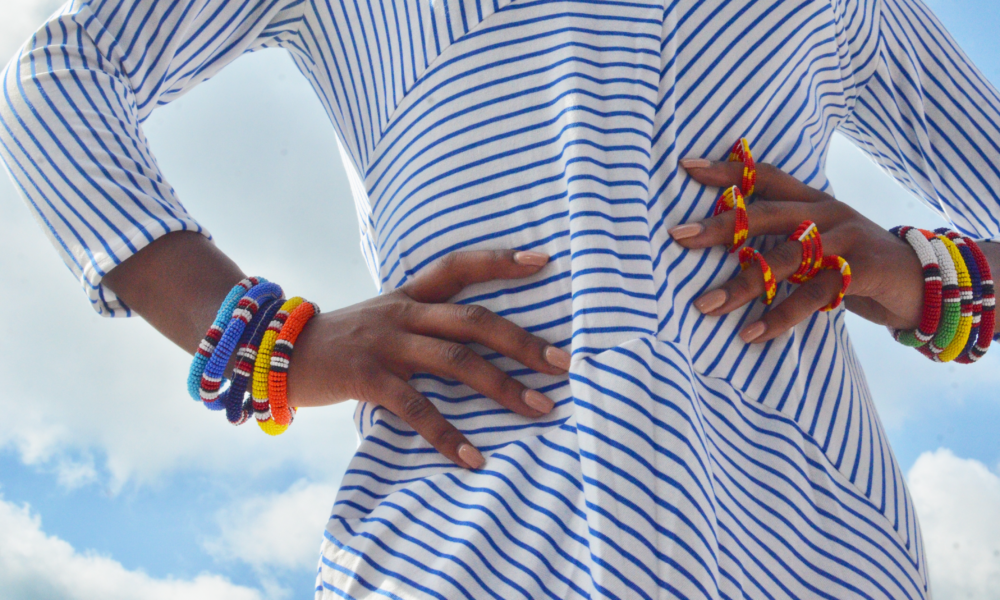There’s a movement in the manufacturing industry to inspire a revolution in the way materials are designed, manufactured and delivered so products are healthy, sustainable, and give more than they take. There is a similar movement and growing trend in the fashion industry—an industry that is the second most polluting industry in the world—to make it more sustainable. Many companies, including the likes of Patagonia, have brought sustainability into their business to further the movement and there is more work to be done.
Tereneh Idia, a fashion designer based in Pittsburgh, PA, is a champion for the sustainable fashion movement and she also wants to take it a step further— making it collaborative, holistic, and circular so it has a positive impact on the planet and people. Her concept can be found in the Global Eco-Design Collaborative. A group she created to bring together Indigenous artisans in a cultural, economic, environmental, and socially supportive system. She works with a group of women artisans in the Maasai community in Kenya and the Oneida Nation in New York. Their collaborative work culminates in stunning designs inspired and created by Indigenous artisans with the benefits going back to the Indigenous community.
This is a true collaboration rooted in a holistic view that fosters authentic connections and dual inspiration. Imagine if this concept was adopted by the larger manufacturing industry? When I met Tereneh, I was immediately drawn to her work, the story of the Maasai and Oneida women, and the influence this could have on the larger manufacturing industry. The following is an interview about Indigenous design partners, human creativity, and a better concept of globalization—one that benefits the world.
Joanna Gangi: Can you explain more about your concept of the Eco-design Collaborative?
Tereneh Idia: I love connections—between people, design, nature—everything. However, the current fashion system is centralized and closed off. For example, there are specific fashion week capitals, the system is very opaque in terms of how things are created and very hierarchical, from what row an editor sits in at a show to who is the It celebrity. Fashion information is also so very controlled including the dirty big secret—that fashion and clothing production is the second most polluting industry in the world. I knew none of this when I started graduate school for design, but once I learned I decided that if I create anything new in this world it had to be sustainable.

Idia’Dega is a global eco-design collaboration and we follow three concepts.
- Creative Force Not Labor Force — the idea of indigenous design partners as equal forces in what we do. So I am not a western designer dictating what the indigenous artisans create. It is a real collaboration.
- Sustain + Ability — sustain human creativity and beauty as well as nature’s and that indigenous innovation and knowledge is relevant today and throughout the future.
- Globalization for Good — round earth thinking. The concept is not flat or one-way influence, power, and dominance but circular holistic that is engaging and benefiting the world. A mentor of mine says I am very idealistic, but all of these concepts are steeped in the natural world and science works.
JG: What are your goals for the collaborative?
TI: Creating a large collective of indigenous artisans in a cultural, economic, environmental, and socially supportive system. This supports the creative community’s economic, political, cultural power. For example, if oil drilling occurs in the Maasai community, in the future we could engage the network to fight as a global community against the drilling. Or on a small scale, which is happening now with the Olorgesailie Maasai Women Artisans of Kenya (OMWA)—the women do a monthly collection of their wages/sales and give it to the family in most need.
There is a saying “Teach a person to fish.” But I went into this process knowing that the women I work with represent the people who invented fishing so it makes more sense to partner as equals together. I am not there to help anyone (in a patriarchal way). We are building this together.
JG: What is the most inspiring thing that you’ve learned from working with the Maasai and the Oneida peoples?
TI: Everything we need we already have, all around us. Also the connections to everything is very prevalent in indigenous cultures. When I was meeting with the Oneida family of The Beading Wolves, to get permission to work with them, I talked about a Maasai creation story. Up to that point in my presentation—no one was responding to anything I was saying. Not a nod or even a blink of the eye. But when I got to the point of the Maasai story, one of the Oneida elders saw a direct parallel with one of their creation stories. He stopped me and said, “Of course! That makes so much sense!” Someone also told me something that I think about everyday, they said, “There is only one body of water on Earth.” We think of separate rivers, lakes, and oceans, but the one water concept, changes how you view, think, and treat everything and everyone. It may sound mystical but a lot of this goes back to nature and science. We are all connected.

JG: What can other people and cultures learn from indigenous cultures about resiliency?
TI: Resiliency from what I have seen and learned from the Maasai and Oneida goes back to understanding the connections. Being able to use what you have at hand. Both the Maasai of Olorgesailie in Kenya and the Oneida of the Beading Wolves know what is around them and they have a deep connection to place. For example, when I got really sick in the Maasai village, the Maasai ladies started making me teas to drink in order to feel better. If we cannot heal ourselves or survive with what is around us, how can we be truly resilient? But on a more fundamental level we need to think about how we sustain each other and our connections with our neighbors, family, etc. Both the Maasai and Oneida have extended community with close ties. I see that is so very important.
JG: Pittsburgh has a rich history in manufacturing and has been in the national media lately regarding the city’s commitment to the Paris Climate Accord. As a Pittsburgh native, how do you feel about many people looking at the region as leading the future of the manufacturing industry and the overall sustainability efforts?
TI: I am lucky enough to have lived all over the country and world so I am also thinking about how things connect, work, and influence across many man-made borders. In Pittsburgh, my concern is not connecting racial economic environmental justice to these new efforts. We are losing basic infrastructure like strong public transportation. Unless we have access to affordable housing, clean water, clean air, good public transportation to move our culturally diverse population of Pittsburgh—the growth of Pittsburgh will continue to be unbalanced and fall along racial lines. Pittsburgh can do a lot better.

JG: Can you explain what the Maasai Solar project is and how it has impacted the community?
TI: When I began working with OMWA: Olorgesailie Maasai Women Artisans of Kenya, one of the Maasai elders said, “This is deeper than you can imagine.” I kind of brushed it off, thinking, ‘Look, I am just here to make pretty dresses and hopefully we all make some money.’ But then I realized that without basic things—access to water, food security—the indigenous communities have all that much more of a hurdle to climb. Add to this how climate change is impacting their lives now. When that river no longer flows, the long walk to water gets longer which means less water for your family and a much longer walk for livestock. It makes the predator animals more aggressive so you lose more livestock. Drought and famine impact human, livestock and plant life making the ecosystem out of balance.
So, what can I do as a fashion designer? Let’s use design as a solution. Following the global eco-design collaboration, the Maasai Solar project is a project in collaboration with Land Art Generator Initiative (LAGI), now based in Seattle. I had met LAGI when they were based in Pittsburgh to connect indigenous design with renewable energy. Connections again that foster circular solutions. The Maasai project will create renewable energy projects that include Maasai design and use from local and global markets. It will house scale, small community scale, and wearables. We are still in the very beginning phase but the goal is to get solar to the community in 2018, with the right support. And then begin to market products in 2019 for the global market with the goal of revenue generation for the Maasai community. We wanted to make sure that the Maasai women’s customers are not just their village neighbors but the world.
JG: What is the meaning behind the name Idia’Dega?
TI: Idia is actually my name and it means “queen mother,” the origin is Benin. There was a specific queen mother that was very powerful in her son’s reign. Traditionally women were not allowed to go to battle but Queen Idia led troops. The saying goes, “No woman goes to battle, except Idia.” ‘Dega comes from Diondega which is the Seneca Haudenosaunee (Iroquois) name for Pittsburgh.
JG: What can the manufacturing industry learn from the Eco-design Collaborative approach?
TI: I begin the process with research and trying to learn as much as possible. I also say to everyone involved, “When I mess up, tell me.” And they do! Connect and be transparent, add more time to the process so that more than one voice or one direction is being considered. Don’t assume that someone from another country without the same education as you is less talented or less intelligent than you. In the end the product is better. When we begin with ideas and the women I work with add to those ideas, they get better and vice versa.

JG: What is one of your favorite designs?
TI: There are two that are my favorites, so far. One from the second collection in 2015 and one from the Spring 2018 Collection we presented during New York Fashion Week in September. The Many As One dress—made from scraps of fabric, hand beaded by OMWA and hand-stitched by me. The HollyTale Necklace was beaded by Holly Gibson of the Oneida Indian Nation, Tale Leah of OMWA and co-designed by me—it represents the strongest melding of all of our global multicultural aesthetic.
JG: What is your message of hope to young people that want to make a positive difference?
TI: I think that young people understand that the time is now. It is the adults that are holding things up. To young people—please know that there is someone in the world born at the exact same day, time, and year as you living thousands of miles away. They have the same desires, hopes, and dreams as you but may not have the same resources and opportunities. But that person is as valuable to this world as you are—we need to see that the world is lopsided but we can do better. If you’re young or old don’t feel overwhelmed with all of the world issues, find one that matters most to you and spend 5 minutes a day on it—call, email, connect to make a difference. It really does make a difference. Also know that we are connected, we are one living family on this planet and we need to sustain each other.


